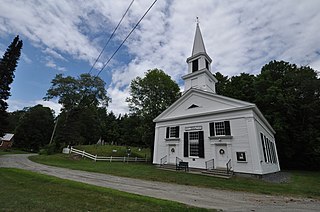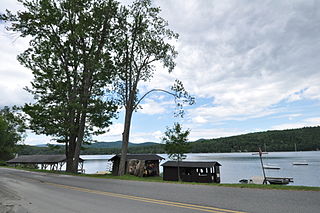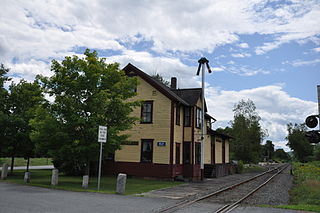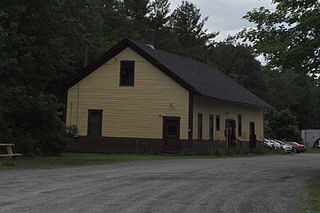
Burlington is the most populous city in the U.S. state of Vermont and the seat of Chittenden County. It is located 45 miles (72 km) south of the Canada–United States border and 95 miles (153 km) south of Montreal. As of the 2020 U.S. census, the population was 44,743. It is the least populous city in the 50 U.S. states to be the most populous city in its state.

Fairlee is a town in Orange County, Vermont, United States. The population was 988 at the 2020 census. It includes the village of Ely. Fairlee is home to Lake Morey, which claims to have the longest ice skating trail in the United States.

West Fairlee is a town in Orange County, Vermont, United States. The population was 621 at the 2020 census.

The U.S. state of Vermont is home to over 100 breweries, microbreweries, nanobreweries, and brewpubs that produce a wide variety of beer.

Camp Billings is a co-ed, summer camp on Lake Fairlee in West Fairlee and Thetford, Vermont, United States. Accredited by the American Camp Association, it was established in 1906, and is open by boys and girls between the ages of eight and sixteen. In 2006, it was listed as a historic district on the National Register of Historic Places.

Bradford is a town in Orange County, Vermont, United States. The population was 2,790 at the 2020 census. Bradford is located on the county's eastern border, bordering both the Connecticut River and New Hampshire, and is a commercial center for some of its surrounding towns.

The Castleton Medical College Building, now known as the Old Chapel, is a historic building of the Castleton Medical College on Seminary Street in Castleton, Vermont, United States. Founded in 1818, it was the first medical college in Vermont, and the first private degree-granting medical school in the United States. The college closed in 1862.

Coolidge State Park is a Vermont State Park located in Plymouth, Vermont, United States. The park is named after Calvin Coolidge, the 30th President of the United States, who was born and raised in Plymouth and is buried there as well. It is the primary recreational center for Calvin Coolidge State Forest, the largest state forest in Vermont. The park's facilities, built by the Civilian Conservation Corps (CCC) in the 1930s, are listed on the National Register of Historic Places.

Gifford Woods State Park is a state park located at the base of Pico Peak in Killington, Vermont. The wooded park provides camping, picnic, and fishing facilities, and has hiking trails, including a portion of the Appalachian Trail. It preserves an area of old-growth forest that has been designated a National Natural Landmark, and is accessible via an interpretive trail. The park was established in 1931. Part of it is listed on the National Register of Historic Places, for facilities developed by the Civilian Conservation Corps in the 1930s.

Aloha Camp is a summer camp for girls on Lake Morey in Fairlee, Vermont. Founded in 1905, it is the oldest girls' camp in the state. Open to children aged 12 to 17, it offers outdoor activities, arts and nature programs, and wilderness camping opportunities. The camp season is divided into two sessions of 3-1/2 weeks, running from late June to mid-August. The camp property is listed on the National Register of Historic Places.

Aloha Hive Camp is a summer camp for girls on Lake Fairlee in West Fairlee, Vermont. Founded in 1915 as an expansion of Aloha Camp, it is open to girls aged 7 to 12, with two sessions between mid-June and late August. The camp operates on more than 400 acres (160 ha), offering a variety of outdoor activities as well as a rich arts and crafts program. The camp facilities were listed on the National Register of Historic Places in 2003.

The Joseph and Daniel Marsh House is a historic farmstead at 1119 Quechee Main Street, just outside the village Quechee in Hartford, Vermont. Built in 1793, it was the home of Joseph Marsh, one of Hartford's early settlers and the first Lieutenant Governor of Vermont. Now the Quechee Inn, the property was listed on the National Register of Historic Places in 1998.

The Ely Railroad Depot is a historic railroad station at Ely Road and Old Route 5 in Fairlee, Vermont. Built in 1900 by the Boston and Maine Railroad, it is a well-preserved rural station, designed to house the stationmaster as well as providing station facilities. It was listed on the National Register of Historic Places in 1994.

The Fairlee Railroad Depot is a historic railroad station at 320 United States Route 5 in the village center of Fairlee, Vermont. Built in 1848 and used in active service until 1972, it is one of the few surviving first-generation railroad station buildings in the state. Now used as a retail space, it was listed on the National Register of Historic Places in 1998.

Fairlee Town Hall, at 75 Town Common Road, is the municipal heart of Fairlee, Vermont. It was built in 1913 to a design by a local architect, replacing the old Fairlee Opera House, which was destroyed by fire in 1912. It is a fine example of Colonial Revival architecture, and is a focal point of the village center and the town's civic life. It was listed on the National Register of Historic Places in 2014.

Lanakila Camp is a private summer camp for boys aged 8-14 on Lake Morey in Fairlee, Vermont. Founded in 1922 on the grounds of a 19th-century farm property, it is one of the state's older organized camps, with a significant number of period buildings in the Adirondack rustic style. The camp offers an array of outdoor activities, including water, field sports, and hiking, as well as indoor arts programs, all generally infused with an educational purpose. It has a full 7-week session, as well as two three-and-a-half-week sessions. During the off-season, its facilities are used as the Hulbert Outdoor Center, an educational center for adults, children, school groups and special events including things like weddings. The camp property was listed on the National Register of Historic Places in 2003.

The Asa May House is a historic farmstead on Blood Brook Road in West Fairlee, Vermont. Developed in the late 18th century, the c.1800 house is a rare statewide example of Federal period architecture, built for West Fairlee's first town clerk. The farmstead property, including a barn, sheds, and period landscape elements, was listed on the National Register of Historic Places in 1993.

The West Fairlee Center Church is a historic church building at Middlebrook and Bear Notch Roads in West Fairlee, Vermont. Built in 1855, it is a fine and little-altered example of rural Greek Revival architecture, also notable for the association of its congregation with Nathaniel Niles, a prominent local minister, landowner, and politician. It was listed on the National Register of Historic Places in 2002.
Sutton Farm is a historic farm property at 4592 Dorset Road in Shelburne, Vermont. Established in 1788, the farm was operated continuously into the late 20th century by a single family, and includes a well-preserved Greek Revival farmhouse. It was listed on the National Register of Historic Places in 2004.
Camp Marbury was a summer camp for girls on Lake Champlain in Ferrisburgh, Vermont. Founded in 1921, the family-run camp operated until 1942, when it closed due to logistical difficulties associated with World War II. The camp property is listed on the National Register of Historic Places.




















